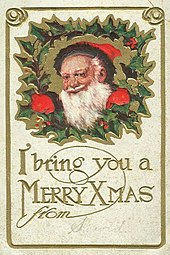Xmas

Xmas adalah sebuah singkatan umum dari kata Christmas (Natal) . Kata ini terkadang dibaca /ˈɛksməs/ dan memiliki varian seperti Xtemass, yang berasal dari singkatan yang ditulis tangan untuk pengucapan /ˈkrɪsməs/. "-mas" berasal dari kata bahasa Inggris Lama yang berasal dari bahasa Latin untuk Misa,[1] sementara "X" berasal dari huruf Yunani Chi, yang merupakan huruf pertama dari kata Yunani Χριστός yang artinya "Kristus".[2]
Terdapat kesalahpahaman umum yang menyatakan bahwa kata Xmas berasal dari upaya kaum sekuler untuk menghilangkan tradisi keagamaan dari Natal[3] dengan membuang kata "Christ" dari "Christmas", tetapi penggunaannya sudah ada sejak abad ke-16.
Penggunaan dalam bahasa Inggris

Penggunaan awal kata "Xmas" digunakan di History of St. Edmund's college, Old Hall karya Bernard Ward (awalnya diterbitkan sekitar tahun 1755).[4] Versi awal, "X'temmas", berasal dari tahun 1551.[4] Sekitar 1100, istilah tersebut ditulis sebagai "Xp̄es mæsse" dalam Kronik Anglo-Saxon.[2] "Xmas" ditemukan dalam sebuah surat dari George Woodward pada 1753.[5] Lord Byron menggunakan istilah tersebut pada 1811.
Catatan kaki
- ^ Catholic Encyclopedia: Liturgy of the Mass. Diakses pada 20 Desember 2007.
- ^ a b "X n. 10.". Kamus Bahasa Inggris Oxford. Oxford University Press. 2011. Diakses tanggal 17 June 2011.
- ^ O'Conner, Patricia T.; Kellerman, Stewart (2009). Origins of the Specious: Myths and Misconceptions of the English Language. New York: Random House. hlm. 77. ISBN 978-1-4000-6660-5.
- ^ a b "Xmas, n.". Kamus Bahasa Inggris Oxford. Oxford University Press. 2011. Diakses tanggal 17 June 2011.
- ^ Mullan, John and Christopher Reid, Eighteenth-century Popular Culture: A Selection, Oxford University Press, 2000, ISBN 978-0-19-871134-6, p 216, retrieved via Google Books, December 27, 2008
Referensi
- Abels, Richard (2005). Alfred the Great: War, Kingship and Culture in Anglo-Saxon England. Longman. hlm. 15. ISBN 0-582-04047-7.
- Bately, Janet M. (1986). The Anglo-Saxon Chronicle: A Collaborative Edition. Vol. 3: MS. A. Cambridge: D.S. Brewer. ISBN 0-85991-103-9.
- Bosworth, Joseph (1823). The Elements of Anglo-Saxon Grammar. London: Harding, Mavor and Lepard.
- Campbell, James; John, Eric; Wormald, Patrick (1991). The Anglo-Saxons. New York: Penguin Books. ISBN 0-14-014395-5.
- Campbell, James (2000). The Anglo-Saxon State. Hambledon and London. ISBN 1-85285-176-7.
- Crystal, David (1995). The Cambridge Encyclopedia of the English Language. Cambridge: Cambridge University Press. ISBN 0-521-59655-6.
- Ekwall, Eilert (1947). The Concise Oxford Dictionary of English Place-Names. Oxford: Clarendon Press. OCLC 3821873.
- Gneuss, Helmut (2001). Handlist of Anglo-Saxon Manuscripts: A List of Manuscripts and Manuscript Fragments Written or Owned in England up to 1100. Medieval and Renaissance Texts and Studies. 241. Tempe: Arizona Center for Medieval and Renaissance Studies. ISBN 978-0-86698-283-2.
- Greenfield, Stanley Brian (1986). A New Critical History of Old English Literature. New York: New York University Press. hlm. 60. ISBN 0-8147-3088-4.
- Harrison, Julian (2007). "William Camden and the F-Text of the Anglo-Saxon Chronicle". Notes and Queries. 54 (3): 222–24. doi:10.1093/notesj/gjm124.
- Howorth, Henry H. (1908). "The Anglo-Saxon Chronicle: Its Origin and History". The Archaeological Journal. 65: 141–204.
- Hunter Blair, Peter (1960). An Introduction to Anglo-Saxon England (edisi ke-3rd). Cambridge: Cambridge University Press. (2003 edition: ISBN 0-521-83085-0)
- Hunter Blair, Peter (1966). Roman Britain and Early England: 55 B.C. – A.D. 871. New York: Norton. ISBN 0-393-00361-2.
- Ker, Neil Ripley (1957). Catalogue of Manuscripts Containing Anglo-Saxon. Oxford: At the Clarendon.
- Keynes, Simon; Michael Lapidge (2004). Alfred the Great: Asser's Life of King Alfred and other contemporary sources. New York: Penguin Classics. ISBN 0-14-044409-2.
- Lapidge, Michael (1999). The Blackwell Encyclopedia of Anglo-Saxon England. Oxford: Blackwell Publishing. ISBN 0-631-22492-0.
- Plummer, Charles (1885). Two of the Saxon Chronicles Parallel.
- Savage, Anne (1997). The Anglo-Saxon Chronicles. Gadalming: CLB. ISBN 1-85833-478-0.
- Smith, Albert Hugh (1935). The Parker Chronicle (832–900). Methuen's Old English Library, Prose Selections. 1. London: Methuen.
- Swanton, Michael (1996). The Anglo-Saxon Chronicle. New York: Routledge. ISBN 0-415-92129-5.
- Thorpe, Benjamin (1861). The Anglo-Saxon Chronicle. Rolls Series. 23. London: Longman.
- Whitelock, Dorothy (1968). English Historical Documents v. 1 c. 500–1042. London: Eyre & Spottiswoode.
- Wormald, Patrick (1991). "The Ninth Century." In Campbell et al., The Anglo-Saxons, 132–159.
- Yorke, Barbara (1990). Kings and Kingdoms of Early Anglo-Saxon England. London: Seaby. ISBN 1-85264-027-8.
Pranala luar


- The Anglo-Saxon Chronicle at Project Gutenberg – Public domain copy.
- The Chronicle from The Cambridge History of English and American Literature, Volume I, 1907–21.
- XML Edition of the Anglo-Saxon Chronicle Diarsipkan 2011-01-01 di Wayback Machine. by Tony Jebson.






